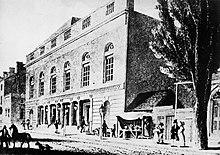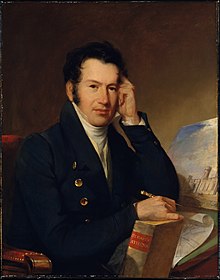John Haviland




John Haviland (born December 15, 1792 in Gundenham , England , † 1852 in Philadelphia , USA ) was an American architect who was a major figure in American classicism and was one of the most famous architects in Philadelphia in the 19th century. He achieved fame especially through his prison buildings.
biography
John Haviland was born in Gundenham, near Taunton in Somerset , England, in 1792 . In 1811 he was apprenticed to the London architect James Elmes . In 1815 he had an unsuccessful meeting with the Russian Imperial Engineer Corps. However, in Russia he met Georg von Sonntag and John Quincy Adams , who encouraged him to work in the United States.
He arrived in Philadelphia in 1816 and soon established himself as one of the city's few professional architects. John Haviland and Mary Wright von Sonntag (daughter of Captain Wilhelm Ludwig von Sonntag of the French Army and sister of George von Sonntag) were married on July 2, 1819 by William White, the Bishop of Pennsylvania. The marriage had a son - John von Sonntag de Havilland.
In 1818 Haviland wrote the book The Builder's Assistant , which was published in three volumes (1818-1821) in order to supplement his meager income as an architect - as with his teaching activities. This was one of the earliest architecture books written and published in North America and probably the first to include the five classical Greek and Roman column orders - for builders , carpenters , masons , plasterers , joiners and carvers ( "for the use of builders, carpenter , mason, plasterers, cabinet makers, and carvers ... " ). In 1830 it appeared again in four volumes.
Partly due to The Builder's Assistant , Haviland received probably the most important orders in Philadelphia in the following period. There he designed the first prison in the USA, which was in line with the ideas of English reformers: the Eastern State Penitentiary (1821-1837) in Gothic style with battlements . He also designed the Franklin Institute (1825–1826) (now the Atwater Kent Museum ) in Philadelphia with a strict Greek Revival facade based on the Monument of Thrasyllus in Athens and the Pennsylvania Institution for the Deaf and Dumb (today: Dorrance Hamilton Hall, University of the Arts (Philadelphia) ).
Haviland opened a drawing school with Hugh Bridgport and later taught drawing at the Franklin Institute mentioned above .
Haviland realized its own speculative real estate projects, including arcades in Philadelphia and New York as well as an amusement park, which turned out to be a flop and was eventually demolished. This resulted in Haviland filing for bankruptcy in the 1830s, which damaged its reputation in Philadelphia. Elsewhere, his reputation as a prison architect brought him important commissions - including prisons in New Jersey , Missouri , Rhode Island and Arkansas .
He designed many churches and private houses predominantly in the Greek Revival style. But The New York Halls of Justice and House of Detention ( The Tombs ) (1835–1838) was built in the Egyptian Revival style. It was meant to instill awe and horror in anyone who saw it. For the first time he used Egyptian details at the New Jersey State Penitentiary near Trenton (1832-1836). This was done partly for reasons of economy, but also to give an idea of the suffering that awaited the people who were to be incarcerated there. So he designed the building lofty, robust and terrifying - with large areas with bare walls and a gloomy portico that extends between two pylons . Egyptian elements can also be found at Essex County Court House and Gaol in Newark, New Jersey (1836–1838). This commitment earned Haviland the reputation of being the most important architect of the American Egyptian Revival.
Haviland was an honorary member and corresponding member of the Royal Institute of British Architects . He died on March 28, 1852 in Philadelphia, where he was buried in the family vault of St. Andrews Church, which he himself designed and which is now the Greek Orthodox Cathedral of St. George.
Today one remembers mainly the prison buildings that Haviland built. The Philadelphia Eastern State Penitentiary, which he designed and which housed inmates until the 1960s, is now a popular tourist attraction.
Architectural work (selection)
Buildings in Philadelphia
- Additions and conversions to Old City Hall (built: 1791) (5th Street and Chestnut Street) (1820)
- First Presbyterian Church (Washington Square Presbyterian), southeast corner of 7th Street and Locust Street (1820–1822) (demolished 1939)
- St. Andrews Episcopal Church, 256 South 8th Street (1822–1823) - since 1922 the Greek Orthodox Cathedral of St. George
- Pennsylvania Institution for the Deaf and Dumb , northwest corner of Broad Street and Pine Street (1824–1826) - now Dorance Hamilton Hall, University of the Arts (Philadelphia)
- Franklin Institute , 15 South 7th Street (1825) - now Atwater Kent Museum
- Philadelphia Arcade, 615-619 Chestnut Street (1826-1827) (demolished in 1860)
- Walnut Street Theaters , 9th Street and Walnut Street (1827–1828) - the oldest continuously operating theater in the United States
- Eastern State Penitentiary , Fairmount Avenue between Corinthian Avenue and North 22nd Street (1821–1829)
- Boston Row, northwest corner of 12th Street and Chestnut Street (1830)
- Independence Hall , 5th Street and 6th Street, second floor renovation (1831) and assembly hall restoration (1833)
- Chinese pagoda and Labyrinthine Garden (1828) - 24th Street and Fairmount Avenue. This amusement park was a flop and was demolished a little later.
- Pennsylvania Fire Insurance Company (1835) (Walnut Street between 5th Street and 6th Street) - of this only the Egyptian front remains, which was integrated into a modern high-rise.
Buildings elsewhere
- US Naval Asylum , Portsmouth, Virginia (1827)
- Miner's Bank, Pottsville, Pennsylvania (1830–1831) (was later demolished)
- New Jersey State Penitentiary near Trenton (1832-1836)
- Reconstruction of the Pittsburgh Penitentiary (Western Penitentiary) (1833–1836)
- The Tombs (Hall of Justice), New York City (1835–1838) (demolished 1902)
- Missouri State Penitentiary, Jefferson City, Missouri (1836) (closed 2004)
- Essex County Court House and Jail , New Street, Newark, New Jersey (1836–1838) - now in a dilapidated state
- Berks County Jail, Reading, Pennsylvania (1848)
- Pennsylvania State Lunatic Hospital, Harrisburg, Pennsylvania (1848-1851)
- Lancaster County Jail, 625 East King Street, Lancaster, Pennsylvania (1851)
- Rhode Island State Penitentiary
- (Old) Allegheny County Jail, Pittsburgh, Pennsylvania
- York County Hall, York, Pennsylvania
- Newark County Hall, Newark, New Jersey
literature
- De Havilland, J. (1865): A Chronicle of the Ancient and Noble Norman Family of de Havilland
Web links
- Haviland biography at www.philadelphiabuildings.org
- Haviland biography at www.ushistory.org
- John Haviland on www.encyclopedia.com
- John Haviland on www.answers.com
- John Haviland on www.ushistory.org
- Information on John Haviland on the Eastern State Penitentiary homepage
Individual evidence
- ↑ a b c d e John Haviland on www.answers.com
- ↑ a b c d e f John Haviland on www.ushistory.org
- ↑ a b c John Haviland at www.encyclopedia.com
- ↑ a b Chinese pagoda and Labyrinthine Garden on lcpdams.librarycompany.org ( page no longer available , search in web archives ) Info: The link was automatically marked as defective. Please check the link according to the instructions and then remove this notice.
- ↑ John Haviland on www.brynmawr.edu ( Memento of the original from October 20, 2013 in the Internet Archive ) Info: The archive link was inserted automatically and has not yet been checked. Please check the original and archive link according to the instructions and then remove this notice.
- ↑ US Naval Asylum on cwpadre.org ( Memento of the original from August 14, 2011 in the Internet Archive ) Info: The archive link was automatically inserted and has not yet been checked. Please check the original and archive link according to the instructions and then remove this notice.
- ↑ Lancaster County Jail on www.fandm.edu ( Memento of the original from June 17, 2008 in the Internet Archive ) Info: The archive link was inserted automatically and has not yet been checked. Please check the original and archive link according to the instructions and then remove this notice.
- ^ "The Civil Engineer and Architects Journal", 1852, p. 227
| personal data | |
|---|---|
| SURNAME | Haviland, John |
| BRIEF DESCRIPTION | American architect |
| DATE OF BIRTH | December 15, 1792 |
| PLACE OF BIRTH | Gundenham , England |
| DATE OF DEATH | 1852 |
| Place of death | Philadelphia , USA |




